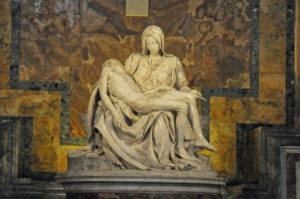
Michelangelo’s Pieta in St. Peter’s Basilica (Photo by Don Knebel)
In 1496, Michelangelo, already well-known at age 21, went to Rome to continue the work as a sculptor he started in Florence. A year later, French Cardinal Jean de Billheres commissioned Michelangelo to create a monument for his funeral, showing Mary holding the body of Jesus. Two years later, Michelangelo unveiled his Pieta, meaning “pity.” The work, carved from a six-foot-high block of Carrera marble, was initially placed in the Chapel of Santa Petronilla, a mausoleum in St. Peter’s that Cardinal de Billheres selected for his interment. When Michelangelo overheard admirers attributing his work to another sculptor, he entered the chapel at night and carved his name in the diagonal ribbon on Mary’s dress, the only time he ever signed his work. The Pieta cemented Michelangelo’s reputation for genius.
In 1749, the Pieta was moved to the Crucifixion Chapel, on the right just after the entrance to St. Peter’s, where it has remained except when it was in New York during the 1964 World’s Fair. In 1972, a mentally ill man attacked the Pieta with a hammer, breaking off Mary’s left arm and her nose. Even though people witnessing the attack walked off with souvenir pieces, including the nose, the Pieta was meticulously restored. Today, bullet-proof glass stands between the work and its millions of admirers. Because the overall design is so natural, most observers overlook the fact that the lower half of Mary’s body is out of proportion, allowing her to hold Jesus’s body unawkwardly in her lap.
Early critics said Mary’s face was too young looking for the mother of the 33-year-old Jesus. Michelangelo said they were ignoring the rejuvenating properties of perpetual virginity. Who knew?